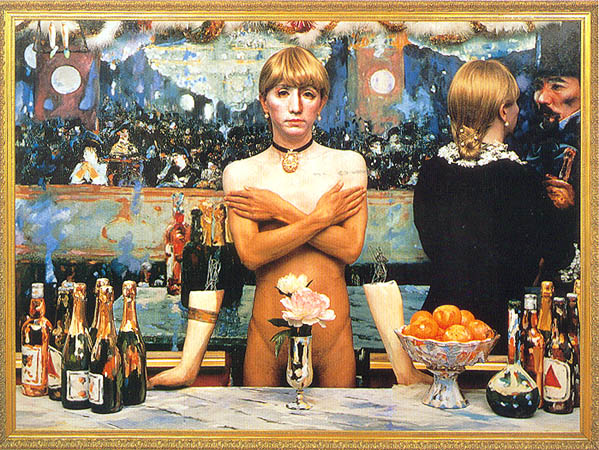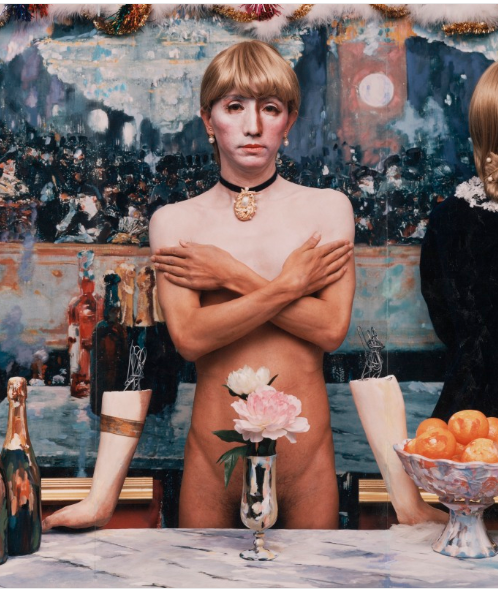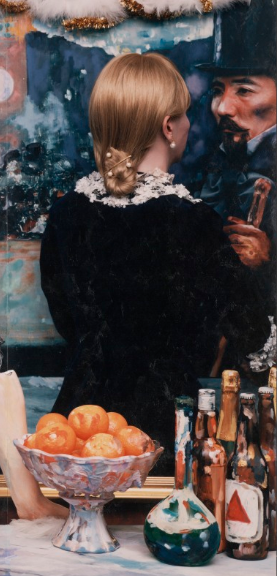Yasumasa Morimura was born in Osaka, Japan, in 1951. He studied arts at the Kyōto City University of Arts where he graduated in 1978. He then stayed on at the university as an assistant, practicing painting, drawing, photography, and wood-block art.
Morimura entered the international stage at the Venice Biennale's Aperto Exhibition in 1988, and then went on to show his pieces in solo exhibitions around the world.
Daughter of Art History (Theater B)
Yasumasa Morimura, Daughter of Art History (Theater B), 1989.
Chromogenic print with transparent acrylic mounted to a wood panel, 180.3 × 246.4 cm (71 × 97 in.).
Image from J. Paul Getty Foundation
The Daughter of Art History (Theater B) was created in Japan in 1989 and is part of a series titled "Self-portrait as art history". This piece is a chromogenic print which was varnished to recreate the texture of brush strokes. Along with Morimura's other self-portraits, this reenactment of Manet's "A bar at the Folies-Bergeres" (1882) is a great example of post-modernist appropriation. In his early work, Morimura chose to become part of Western paintings as a commentary on the influence of Western art in Japan and the tension between a traditionally male-dominated society and newly emerging female values.
Although some critics wondered whether his self-portraits could be considered art or just imitations, Morimura's ability to become one with the original paintings makes his pieces unique and leaves the viewer with plenty of food for thought. Without trying to make a statement about gender identity, he commented on, and questioned, traditional beliefs of his time.
For Morimura, the concept of art is simple: "[…] art is the same as god. God exists in people who believe that god exists. But it does not exist in people who have no faith. In the same way, art exists if there are people who believe in art." (Mori Art Museum, 2010)
The context
The Daughter of Art History (Theater B) was created in a period of turmoil. For two decades cultural nationalism had linked Japan's economic growth and success with the unique nature of Japanese traditions and hierarchical society. However, when the economic bubble began to burst and the first signs of inequality appeared in the fabric of society, some began to question those respected traditions, and to advocate for much needed reforms.
Some aspects of this piece are as topical now as they were in the 80s and 90s: the role of women within in society, gender identity and its perceived importance and place in societal interactions are still being defined.
The message
The self-declared purpose of Morimura's work is to generate an emotional reaction to beauty, but there is also a sense of unease carefully hidden behind the beauty. A lot is left unsaid, so the viewers are free to make up their mind on why they are touched by this work. Morimura's piercing, sad eyes capture the viewer and talk about two worlds, past and present, merging: have we moved forward or are we still plagued by the same issues?
The tools
Although the composition of this piece is mainly dictated by the original artwork by Manet, Morimura has carefully woven in additional elements to guide the viewer's eye around the image.
As shown above, the tone of the artist's skin matches many of the surrounding colours blending his naked figure into the original painting.
The light complexion and central positioning of the barmaid has been preserved to ground and balance the whole image, and to draw attention to the main character of this story. The contrast between the fair skin (achieved through make up that is reminiscent of that traditionally worn by Japanese geishas) and Morimura's deep dark eyes draws the viewer towards his gaze.
The contrast between the skin tone of the upper and lower body draws attention to the placement of the folded arms: is the barmaid despondent towards her situation or is she trying to protect herself?
The triangle created by the folded arms then guides the eye towards the strategically placed vase, moved from its original position, and the bright roses.
Once the eye is left free to wander around the rest of the image, the arms of the original barmaid seem to materialise on the counter. However, they are not just a simple remnant of Manet's work: Morimura has added wires to their structure, as if the barmaid wasn't real, just a construct, a mannequin or a robot, and only her arms are left behind.
Finally the eye moves towards the two of figures on the right hand side, the last ones with distinguishable features.
One is the barmaid's reflection: interestingly Morimura has decided to leave the reflection fully clothed, maybe to suggest that her clothes are an armour the barmaid wears to protect herself, to keep herself safe from the disreputable men who frequent her bar. The naked figure standing in the middle of the piece is her real self, a vulnerable woman working in a man's world.
Morimura's final touch is his impersonation of the male customer on the far right of the image. He is gazing over the barmaid's shoulder: does he see himself in the woman who stands before him or is he afraid to meet her gaze?
There seems to have been a power shift, or maybe even a role reversal, between the characters in Manet's painting and Morimura's piece: the man no longer towers over the woman with a dominant almost dangerous look on his face, he seems lost in thought.
There is an uneasiness about this piece, generated by the many paradoxes included in the imagery. The same person is in three places at once, a naked woman has a clothed reflection and someone (or something's) arms are resting on a counter, posed like they are waiting for their owners to come back and claim them.
The rethoric
Is this piece credible? The (art world) jury seems to still be out. Is it ethical to appropriate artwork? Postmodernists definitely thought so.
Morimura's meticulous reconstruction of the scene and his reinterpretation of the characters reinforce the dilemma. Despite being aware of the deceptive nature of the this piece, the viewer cannot ignore the power and the soulfulness of the image he has created.
The contrast between the modern medium of photography and the impressionist strokes, the man posing as a woman, then as a man again generate an emotional response. Empathy towards the barmaid and her vulnerable state, sadness for the man and his lost gaze are just some of the feelings instigated by Morimura's work.
Strong in its postmodernist style and unique to its geographical origins, this piece remains topical while being timeless in an age were society seems to be craving a revival of old beliefs.
Cindy Sherman, Untitled #66, 1980 - Image from MOMA
Morimura's idea of posing in paintings and photographs as famous characters and pop icons is aligned with other postmodernist work, like that of Cindy Sherman for example and contributes to the postmodernist perspective on appropriation.
Morimura's careful reconstruction of Manet's work and his empathic approach to the reinterpretation of his characters suggest a deep connection to that work and a great ability to build parallels between the human condition of days past and that of today. The Daughter of Art History was created to emulate a painting, so its viewing envinroment possibly meant to be a gallery. With the advent modern technology, his amazing work can now be appreciated online either from the comfort of one's home or on the go.







